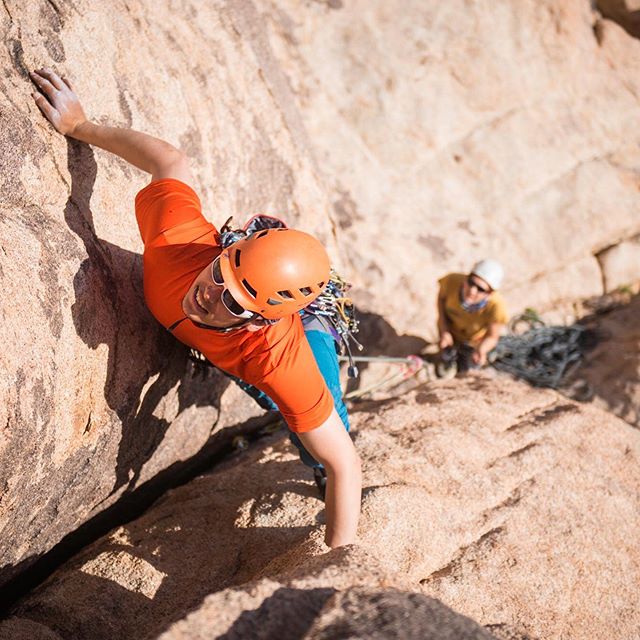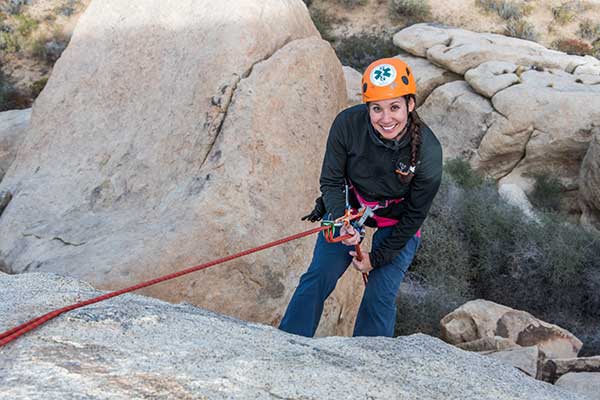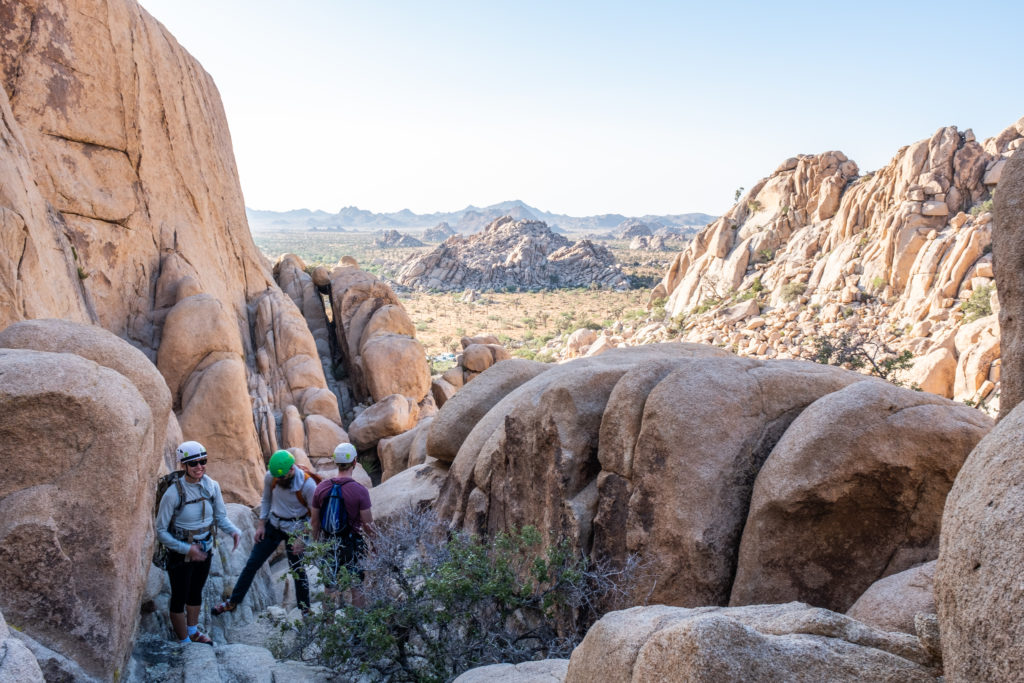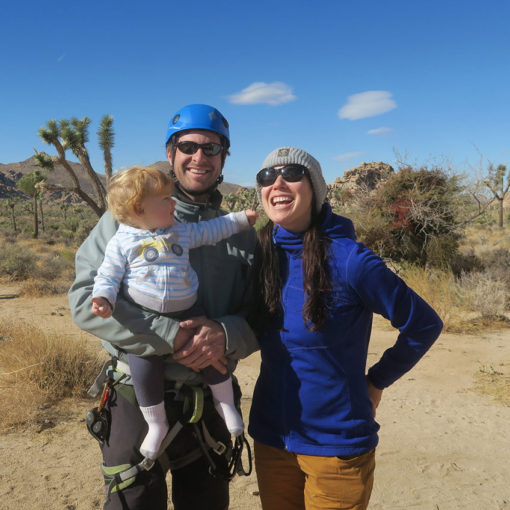Planning your next rock climbing adventure? There are a few important things to consider when preparing for your rock climbing trip in Joshua Tree National Park including what to bring, access issues, and route planning.
Check out our guide on what you can expect and how to prepare for your rock climbing trip!
What to Bring to Your Rock Climbing Trip

At any time of year, there can be a huge swing in temperatures, up to 30 degrees, from morning, to mid-day, back down to night.
The summers reach the triple digits, and the winters can drop to below 20 degrees Fahrenheit. For most of the year (fall through spring), you will need to prepare layers of clothing and jackets including cooler layers underneath long sleeve shirts, wind breakers, and down jackets. The rock is rough and between crack climbing, epic down climbs and the prickly, thorny plants, so wearing long pants can cut down on blood shed throughout the day. Even in the summer, cool, light clothing that covers most of your skin from the hot blazing sun can help toward saving energy, avoiding sun burns, and help the body keep in more moisture.
These are things to keep in mind well ahead of time when you are planning your trip. Once your climbing trip is only 1-2 out, however, you can then get an accurate weather update and better plan your day.
In the high desert, there is not only a wide swing in temperatures, but it also feels as though there is a 20 degree difference between the sun and shade. Choosing to get on routes at the right time can go a very long way toward comfort and even sending at your limits. If it is a hot day, plan to climb in the shade. If it will be a frigid cold day, choose routes in the sun. This will mean east facing walls in the morning and west facing walls in the evening.
In the winter, south facing walls get all day sun and north facing walls are often all day shade. Most climbing guide books give sun/shade information based on the trends during peak season dates (October-March). During these months the sun is lower in the sky, making South Facing walls warm and toasty options for cold days. Remember, however, that despite what the guide book may say, there is no such thing as all day shade in the summer months. Finding shade will depend on being on east or west facing walls at the right time of day.

Joshua Tree is in the Mojave Desert, the driest region in North America. This makes staying hydrated a little extra work! For a full day of climbing, each climber should be prepared with one gallon of water. In the hotter months, be sure to drink plenty of hydrating liquids, electrolytes and snack on salty foods. On cold winter days, a thermos of something hot to drink and sugary snacks can really help with keeping your energy flowing. Whatever the case, you will need to pack everything in as there are no services in the Park and you will not find any running water to replenish your water bottles with. Likewise, you will need to plan on packing everything out. Beware of gusty winds carrying away your stray pieces of food packaging.
As for climbing. be prepared for building most of your own anchors. Even though there are some bolt protected routes and the occasional bolted anchors out here, Joshua Tree is primarily a trad climbing area and full rack, long cordalettes, and 60+ ft static ropes all come in handy for anchor building in Joshua Tree. Unfortunately, there are some bolt wars in Joshua Tree National Park as well. Don’t always trust to find a bolted anchor just because someone documented one 10 years ago. Doing the research, or checking out the ‘walk off’ prior to jumping on a climb can go a long way in avoiding epics when it comes to getting off of a crag.
The comments on Mountain Project usually have the most up to date information of when to expect on route. As for what length of rope to bring, 60 meter ropes are enough for most routes in Joshua Tree. Finally, keep in mind that the rock climbing grades in Joshua Tree are ‘traditional’, not at all like the other modern climbing areas in Southern California. Grades can feel quite spicy by 5.8+/5.9. Plan accordingly to avoid epic regrets.
Access Issues You May Encounter in Outdoor Climbing Areas
As is the case for any outdoor climbing areas, rock climbers have the ethical obligation to understand the access issues of the area. In most cases, environmental concerns and visiting the area in a low impact way are front and center to the topic of access. Joshua Tree National Park, like most desert areas have a very fragile topsoil. And while the native plants may be incredibly hardy to heat and cold as well as drought, they are vulnerable to human impact. Understanding how fragile the topsoil in the desert is key to knowing how to recreate in the desert in a low impact way.
The surface of undisturbed desert soil is held together by a cryptobiotic net of tiny plants and lichens. This microscopic net holds together the dirt and sand against 60+ mph winds, and release nitrogen and organic acids into the ground for other native plants to grow. This cryptobiotic net protects and serves all the other desert plants we see growing. It is incredibly fragile and can be broken up with just one footstep. Off-roading, sliding across the surface, dragging crash pads, or otherwise overturning the topsoil all kill this cryptobiotic net, and it takes years for it to grow back. To help preserve this topsoil, climbers should stay on access trails, washes and hard surfaces (rocks).
A growing problem in Joshua Tree National Park is all of the “social trails” developing around climbing formations. These come about when people choose to walk side by side, fanning out and trampling through more pristine desert than their group needs to on their way to a route. Please take the time to identify the climbing access trail, walk single file with your group to on that trail and take special care not to accidentally wind up on a false ‘social trail’ on the way out. This is becoming more and more difficult as there are fine little trails sprawling in every which way around climbing crags. When in doubt, take the more well beaten path!

Joshua Tree National Park is not just an international destination for rock climbing, it is also an international destination for bird watching! And falcons and other birds of prey occasionally build their nests on top of climbing formations. When this happens, a notice will go out from Joshua Tree National Park that the crag is closed for falcon nesting. The information can usually be found on Mountain Project or directly from Joshua Tree National Park’s website or social media.
Finally, Joshua Trees are not actually trees. They are yuccas and have a very fragile root system. Unlike trees, the roots of yuccas cannot handle the weight of people climbing or hanging hammocks on them. Remember these are protected plants due to their slow growth, limitations on where they can grow and limited rainfall that they survive with. Even if your hammock does not immediately tear down a Joshua Tree, it could still damage the roots making that Joshua Tree more likely to fall during the next storm that blows 60-70 mph winds.
Thank you for being respectful enough to research this topic before entering the Park. Please help spread the word during your visit! Ready to plan a rock climbing adventure with us? Book online today!





One thought on “What to Expect During Your Rock Climbing Trip”